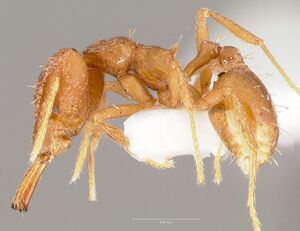Strumigenys fronto
| Strumigenys fronto | |
|---|---|

| |
| Scientific classification | |
| Kingdom: | Animalia |
| Phylum: | Arthropoda |
| Class: | Insecta |
| Order: | Hymenoptera |
| Family: | Formicidae |
| Subfamily: | Myrmicinae |
| Tribe: | Attini |
| Genus: | Strumigenys |
| Species: | S. fronto |
| Binomial name | |
| Strumigenys fronto Fisher, 2000 | |
Known primarily from dry-forest litter samples, one collection was made from a soil nests.
Identification
Bolton (2000) - A member of the carisa complex in the Strumigenys arnoldi-group. S. fronto can easily be isolated by the presence of only 1 preapical tooth on left and right mandibles, a long stiff projecting filiform hair on each pronotal humerus and the dorsolateral margin of the head posteriorly with 2-3 stiff erect hairs that are longer than hairs on leading edge of scape. See Strumigenys carisa for further discussion.
Keys including this Species
Distribution
Latitudinal Distribution Pattern
Latitudinal Range: -18.0264° to -18.0264°.
| North Temperate |
North Subtropical |
Tropical | South Subtropical |
South Temperate |
- Source: AntMaps
Distribution based on Regional Taxon Lists
Malagasy Region: Madagascar (type locality).
Distribution based on AntMaps
Distribution based on AntWeb specimens
Check data from AntWeb
Countries Occupied
| Number of countries occupied by this species based on AntWiki Regional Taxon Lists. In general, fewer countries occupied indicates a narrower range, while more countries indicates a more widespread species. |

|
Estimated Abundance
| Relative abundance based on number of AntMaps records per species (this species within the purple bar). Fewer records (to the left) indicates a less abundant/encountered species while more records (to the right) indicates more abundant/encountered species. |

|
Biology
Castes
Worker
Images from AntWeb
   
| |
| Paratype of Strumigenys fronto. Worker. Specimen code casent0005539. Photographer April Nobile, uploaded by California Academy of Sciences. | Owned by CAS, San Francisco, CA, USA. |
   
| |
| Paratype of Strumigenys fronto. Worker. Specimen code casent0005540. Photographer April Nobile, uploaded by California Academy of Sciences. | Owned by CAS, San Francisco, CA, USA. |
   
| |
| Paratype of Strumigenys fronto. Worker. Specimen code casent0005541. Photographer April Nobile, uploaded by California Academy of Sciences. | Owned by CAS, San Francisco, CA, USA. |
Nomenclature
The following information is derived from Barry Bolton's Online Catalogue of the Ants of the World.
- fronto. Strumigenys fronto Fisher, in Bolton, 2000: 660, figs. 397, 419 (w.) MADAGASCAR.
Unless otherwise noted the text for the remainder of this section is reported from the publication that includes the original description.
Description
Worker
Holotype. TL 3.5, HL 0.85, HW 0.73, CI 86, ML 0.46, MI 54, SL 0.56, SI 76, PW 0.39, AL 0.84. Characters of carisa-complex. Each mandible with 1 preapical tooth which is situated in the apical third; preapical tooth on left mandible usually smaller than tooth on right. Upper scrobe margin bordered by a very narrow laminar rim throughout its length, eyes partially visible in full-face view. Eye small, convex, its maximum diameter slightly greater than maximum width of scape. Eye located slightly inwards from margin and apex formed by the junction of the posterior preocular notch and ventral scrobe margin. Scape more or less subcylindrical, basal portion slightly expanded and approximately straight; hairs on leading edge narrowly spatulate. Cephalic dorsum densely clothed with curved narrowly spatulate ground-pilosity; upper scrobe margin fringed with hairs that are similar in size and shape to those on the dorsum. Cephalic dorsum with 7 pairs of long stout standing remiform hairs arranged as follows: transverse row of 3 pairs close to the occipital margin; dorsolateral margin posteriorly with 3 pairs of hairs that are longer than hairs on leading edge of scape; 1 pair on vertex. Pronotal humeral hair long and stout, filiform and projecting; humeral angles rounded. Mesonotum with 1 pair of stout standing narrowly spatulate hairs on anterior margin. Propodeum with two pairs of short, posteriorly curved hairs immediately anterior of propodeal spines. Ground-pilosity on alitrunk dorsum as on head but sparser. Dorsum of alitrunk in outline convex anteriorly, posterior alitrunk gradually sloping down to declivity, anterior propodeum slightly raised above posterior mesonotum. Metanotal groove represented by a shallow impression. Propodeal spines narrowly triangular, margins spongiform; propodeal lamella absent. Alitrunk dorsum and sides of pronotum densely reticulate-punctate. Pleurae mostly reticulate-punctate, katepisternum and central portion of metapleuron partially smooth. Petiole node in dorsal view approximately as long as broad. Postpetiole disc reticulate-punctate. In profile ventral spongiform tissue of petiolar peduncle a narrow, irregular strip that is continuous along the base of the peduncle, maximum depth of strip slightly less than the maximum width of eye. Ventral spongiform tissue of postpetiole moderately developed. Basigastral costulae short, distinct and widely spaced. Dorsal surface of petiole, postpetiole, and gaster with stout standing remiform to narrowly spatulate hairs. Colour medium brown.
Paratypes. TL 3.3-3.7, HL 0.80-0.88, HW 0.68-0.76, CI 85-90, ML 0.44-0.49, MI 52-57, SL 0.53-0.56, SI 73-78, PW 0.37-0.41, AL 0.76-0.86 (8 measured). As holotype.
Type Material
Holotype worker, Madagascar: Causse de Kelifely, 20-30.xi.1974, forest humus and litter, dry forest (A. Peyrieras) (Museum of Comparative Zoology).
Paratypes. 9 workers with same data as holotype (The Natural History Museum, South African Museum).
References
- Fisher, B.L. 2000. The Malagasy fauna of Strumigenys. Pp. 612-696 in: Bolton, B. 2000. The ant tribe Dacetini. Memoirs of the American Entomological Institute. 65:1-1028. (page 660, worker described)
References based on Global Ant Biodiversity Informatics
- Bolton, B. 2000. The Ant Tribe Dacetini. Memoirs of the American Entomological Institute 65
- Fisher B. L. 2003. Formicidae, ants. Pp. 811-819 in: Goodman, S. M.; Benstead, J. P. (eds.) 2003. The natural history of Madagascar. Chicago: University of Chicago Press, xxi + 1709 pp.

